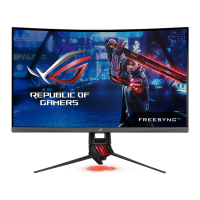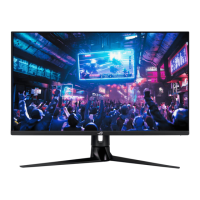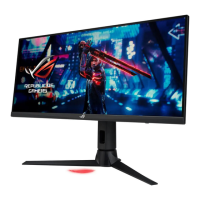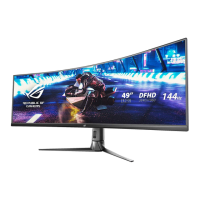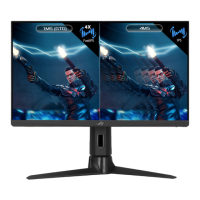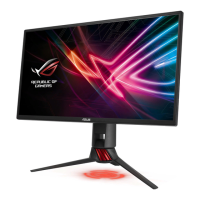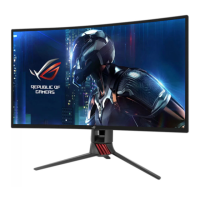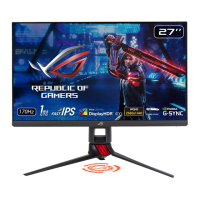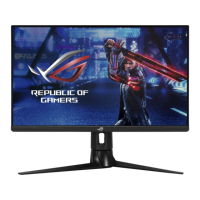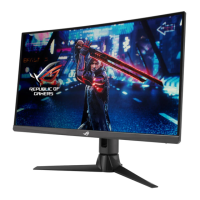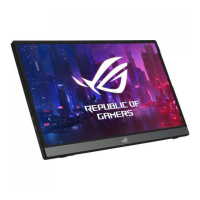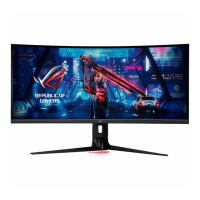
Do you have a question about the Asus ROG STRIX XG349C Series and is the answer not in the manual?
| Screen Size | 34 inches |
|---|---|
| Panel Type | IPS |
| Response Time | 1ms (GTG) |
| Aspect Ratio | 21:9 |
| HDR | HDR400 |
| Contrast Ratio | 1000:1 |
| Curvature | 1900R |
| Viewing Angle | 178°/178° |
| Speakers | 2x 2W |
| VESA Mount | 100 x 100 mm |
| Resolution | 3440 x 1440 |
| Refresh Rate | 180Hz |
| Brightness | 400 cd/m² |
| Ports | 1x DisplayPort 1.4, 2x HDMI 2.0, 1x USB-C |
| Adaptive Sync | NVIDIA G-SYNC Compatible |
| Color Gamut | 98% DCI-P3 |
| USB Hub | Yes |
| Ergonomics | Height, Tilt, Swivel |
Covers setup, handling, electrical safety, and ventilation requirements for safe operation.
Instructions for securing the monitor to a wall using a cord or chain to prevent falls.
Guidelines for safely cleaning the monitor screen and cabinet using appropriate materials.
Information on not placing the product in municipal waste and checking local regulations.
Information on accessing ASUS websites for product and software updates.
Note about optional documentation that may be included with the product.
Highlights the crisper, broader, and brighter display and enhanced viewing experience.
Lists all items included in the product package for user verification.
Detailed steps and illustrations for assembling the monitor arm and base.
Identifies and labels all ports located on the rear of the LCD monitor.
Explains how to use the navigation and function buttons on the monitor.
Details the power indicator light colors and the function of the power button.
Explains the functions of navigation buttons for OSD menu interaction.
Steps to activate and use GamePlus features like crosshair, timer, and FPS counter.
Overview of GamePlus main menu and its sub-features like Crosshair and Timer.
Instructions on how to activate and select different GameVisual picture modes.
Details Scenery, Racing, Cinema, RTS/RPG, FPS, and sRGB modes.
Step-by-step guide to safely detach the monitor stand for VESA wall mounting.
Guidance on adjusting monitor angle and height for comfortable viewing.
Details the monitor's swivel range (25°) and tilt range (-5° to 20°).
Step-by-step guide to navigating and changing settings within the OSD menu.
Details on adjusting refresh rate via Overclocking and response time via Over Drive.
Explains VRR for smooth visuals and its activation conditions.
Describes ELMB/ELMB SYNC to reduce motion blur and ghosting.
Configuration of image parameters including brightness, contrast, HDR, and VividPixel.
Information on configuring GamePlus for gaming and GameVisual for picture modes.
Adjusts gamma to enhance visibility in dark scenes for better object detection.
Allows selection of color temperature (Cool, Normal, Warm, User Mode).
Adjusts color gamma levels and saturation for desired color output.
Configuration for PIP/PBP modes, source selection, color settings, and size.
Controls Aura Sync for synchronized lighting and Aura RGB patterns on the monitor.
Allows users to assign functions to shortcut keys and save custom settings.
Options for selecting OSD language and adjusting volume/mute.
Configuration for USB hub operation, power indicator, and power key lock.
Steps to enable Aura Sync and configure Aura RGB lighting effects via Armoury Crate.
Details panel size, resolution, brightness, contrast, response time, and viewing angles.
Lists supported ports (USB, HDMI, DP, Type-C), power consumption, and voltage.
Provides physical dimensions with/without stand, box dimensions, and weights.
Specifies the recommended operating and storage temperature ranges for the monitor.
Solutions for power LED not turning on or screen image not appearing.
Addresses issues like light/dark images, screen bounce, wave patterns, and color defects.
Solutions for no sound or low volume problems.
Lists supported resolutions, horizontal/vertical frequencies, and DCLK for PC inputs.
